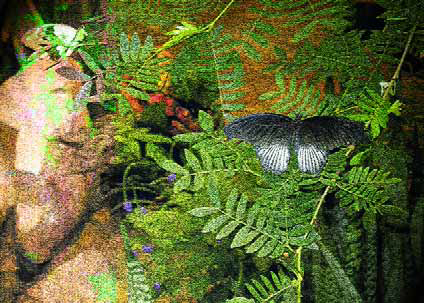pond
As a rule, those of us who build watershapes meant for purposes other than swimming or hydrotherapy tend to pursue one path or another: Either we make our ponds, streams and waterfalls look as natural as we can manage, or we establish them to reveal the hand of man either partly or completely. In that either/or context, successful design depends at least in part on being perfectly clear with ourselves about what we are trying to achieve. In assessing ponds of these opposing forms, it's my personal practice to look at both natural ponds and formal ponds (or, more accurately, architectural ponds) as being right on par with one another with respect to their potential for beauty. Indeed, architectural ponds can be incredibly appealing when done up in such a way that
In pre-Colonial days, the neck of the woods now known as Longwood Gardens was a hunting ground for the Lenni Lenape tribe, who prized the area for the richness of its game and timber. Once the British arrived, the land moved under the control of William Penn, founder (and namesake) of Pennsylvania, who sold it to a Quaker family by the name of Pierce in the year 1700. The family farmed the property until 1798, when Joshua and Samuel Pierce began planting an arboretum and the space that would one day become Longwood Gardens was born. Those of us living in the Philadelphia area have long enjoyed the privilege of having this resource in nearby Kennett Square, Pa. It's an amazing place, and I find my way there often because it seems that each time I go, there's something
In pre-Colonial days, the neck of the woods now known as Longwood Gardens was a hunting ground for the Lenni Lenape tribe, who prized the area for the richness of its game and timber. Once the British arrived, the land moved under the control of William Penn, founder (and namesake) of Pennsylvania, who sold it to a Quaker family by the name of Pierce in the year 1700. The family farmed the property until 1798, when Joshua and Samuel Pierce began planting an arboretum and the space that would one day become Longwood Gardens was born. Those of us living in the Philadelphia area have long enjoyed the privilege of having this resource in nearby Kennett Square, Pa. It's an amazing place, and I find my way there often because it seems that each time I go, there's something
I see gardens as entire worlds unto themselves - as complete and alive and distinct rather than as simple decorative extensions of architecture. Whatever form they might take, these spaces should carry us back into the peaceful parts of ourselves and to the calm, clear realms of our minds and spirits. This outlook has, in my role as founder and principal of Marpa Design Studio of Boulder, Colo., led me to consider landscapes as integrated wholes rather than as cobbled assemblies of solutions to various problems. It's a positive philosophy and design approach that is fully on display in the project depicted on these pages. I was recommended by the architect, who was working with the owners of this sprawling Rocky Mountain estate on a major renovation of both the home and the surrounding land. From the start, I was told there was just one major theme in mind: The home and its surroundings were to look as natural as possible - as though everything had arisen organically from the roots of the mountains. Neither house nor grounds possessed that spirit at the time, and the landscape was particularly deficient. Indeed, the only pre-existing feature was a cracked
One person’s error is often another’s opportunity – and that’s exactly how my relationship with Disney’s Epcot Center began. The famous Florida theme park has held its International Flower & Garden Show in the spring for many years now, and one of the festival’s more popular highlights has long been the program’s “Water Garden Wonders” exhibit. A local Floridian pond contractor had always taken care of the waterfeatures for the show, but after a series of problems, officials at Disney decided to make a change and I was contacted to see if our company, Aquascape of St. Charles, Ill., would be interested in taking over the pond-construction duties. I was immediately on board with the idea. After all, how do you say no to
In December 2004, WaterShapes introduced ‘The Platinum Standard,’ a registry of projects that embodies watershaping…
In December 2004, WaterShapes introduced ‘The Platinum Standard,’ a registry of projects that embodies watershaping at its finest. Now, as part of our celebration of the magazine’s 100th Issue, Eric Herman offers ‘The Platinum Standard II,’ a fresh set of 20 projects that have graced the pages of the magazine in the past three-and-a-half years – projects that demonstrate clearly that watershaping has become an art form in its own right. I’ll never forget the day Jim McCloskey suggested starting a magazine on systems that contain and control water. We were walking near his home in Woodland Hills, Calif., when he broached the idea, saying it had come to him as something of an epiphany while
Last month, we began describing our work on an indoor butterfly garden for the Strong Museum in Rochester, N.Y. – an extremely challenging design/build project that required us to work as part of a large team in developing a complex garden, pond and waterfall composition. While the resulting butterfly-oriented design was definitely unusual in form and execution, it was also highly unusual in the convoluted way our firm became involved and in the complexities of





















Anthony Archer Wills